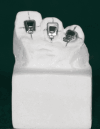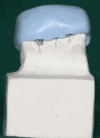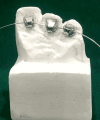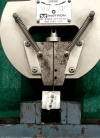A Comparative Evaluation of Frictional Resistance of Various Lingual Brackets With Nitinol (NiTi) Archwires of Different Dimensions: An In Vitro Study
- PMID: 38993465
- PMCID: PMC11238752
- DOI: 10.7759/cureus.62121
A Comparative Evaluation of Frictional Resistance of Various Lingual Brackets With Nitinol (NiTi) Archwires of Different Dimensions: An In Vitro Study
Abstract
Introduction Orthodontic mechanics involves transferring some of the applied force to the tooth's supporting components via friction, which in turn allows the tooth to move more easily. Aim The purpose of this in vitro experiment was to examine the frictional resistance (FR) of different lingual brackets utilizing Instron universal testing machines and nitinol (NiTi) archwires of varying sizes. Materials and methods Twenty-four sectional anterior die stones were replicated from a study model. They were categorized into eight categories, with the Libral lingual bracket and the JJ lingual bracket having 0.012" and 0.014" inch NiTi archwire, which were further subdivided into six subgroups. Three brackets were bonded to the anterior teeth of the upper and lower segments and replicated on other models with the help of silicon putty. Elastomeric modules were ligated to two diameters of NiTi wire (0.012" and 0.014") in each model. An Instron universal testing machine was used to measure the frictional force. Numerical data and descriptive statistics such as mean and standard deviation have been shown. Results In the overall analysis, it was observed that among JJ Orthodontics samples using 0.012" NiTi archwires, the maxilla exhibited a higher FR (4.205N) compared to the mandible (4.092N). Similarly, in the case of Libral Orthodontics samples with 0.012" NiTi archwires, the maxilla also demonstrated a higher FR (5.10N) than the mandible (4.97N). However, this trend did not hold for samples using 0.014" NiTi archwires. There was a statistically nonsignificant difference (p > 0.05) in the values between all the pairs of groups. Conclusion The present study concludes that Libral lingual brackets produced overall more FR than JJ lingual brackets.
Keywords: frictional resistance; lingual brackets; niti wires; orthodontics; universal testing machine.
Copyright © 2024, Ranjan Padhi et al.
Conflict of interest statement
Human subjects: Consent was obtained or waived by all participants in this study. Bharati Vidyapeeth (Deemed to be University) Dental College and Hospital issued approval BVDU/DCH/NM/1857/2021-22. Animal subjects: All authors have confirmed that this study did not involve animal subjects or tissue. Conflicts of interest: In compliance with the ICMJE uniform disclosure form, all authors declare the following: Payment/services info: All authors have declared that no financial support was received from any organization for the submitted work. Financial relationships: All authors have declared that they have no financial relationships at present or within the previous three years with any organizations that might have an interest in the submitted work. Other relationships: All authors have declared that there are no other relationships or activities that could appear to have influenced the submitted work.
Figures







Similar articles
-
An in vitro Evaluation of Friction Characteristics of Conventional Stainless Steel and Self-ligating Stainless Steel Brackets with different Dimensions of Archwires in Various Bracket-archwire Combination.J Contemp Dent Pract. 2017 Aug 1;18(8):660-664. doi: 10.5005/jp-journals-10024-2102. J Contemp Dent Pract. 2017. PMID: 28816185
-
Mechanical Properties and Potential Clinical Implications of Improved Superelastic Orthodontic Archwires: An Observational Study.Cureus. 2023 Nov 5;15(11):e48334. doi: 10.7759/cureus.48334. eCollection 2023 Nov. Cureus. 2023. PMID: 38060728 Free PMC article.
-
Comparative Evaluation of Frictional Resistance Between Different Types of Ceramic Brackets and Stainless Steel Brackets With Teflon-Coated Stainless Steel and Stainless Steel Archwires: An In-Vitro Study.Cureus. 2022 Apr 15;14(4):e24161. doi: 10.7759/cureus.24161. eCollection 2022 Apr. Cureus. 2022. PMID: 35586355 Free PMC article.
-
Comparison of Friction Produced at Backet-Wire Interface in Monocrystalline Ceramic Brackets of 8 Different Brands: An In Vitro Study.J Pharm Bioallied Sci. 2024 Feb;16(Suppl 1):S356-S358. doi: 10.4103/jpbs.jpbs_572_23. Epub 2024 Feb 29. J Pharm Bioallied Sci. 2024. PMID: 38595439 Free PMC article.
-
Friction and archwire engagement in contemporary self-ligating appliance systems : An in vitro comparison.J Orofac Orthop. 2023 Apr;84(Suppl 2):65-73. doi: 10.1007/s00056-021-00361-8. Epub 2021 Nov 15. J Orofac Orthop. 2023. PMID: 34779866 English.
References
-
- Aesthetic orthodontics: an overview. Patel D, Mehta F, Mehta N. Orthod J Nepal. 2014;4:38–43.
-
- Scuzzo G, Takemoto K. Invisible Orthodontics: Current Concepts and Solutions in Lingual Orthodontics. USA: Quintessence International; 2003. Invisible Orthodontics: Current Concepts and Solutions in Lingual Orthodontics.
-
- Evolution of lingual brackets - a historical perspective. Yezdani AA, Kumar MS. https://ejmcm.com/uploads/paper/9715ae5097cb0e8bbe6d6016bef75e97.pdf Eur J Mol Clin Med. 2020;7:6453–6457.
-
- Bending characteristics of nitinol wire. Lopez I, Goldberg J, Burstone CJ. Am J Orthod. 1979;75:569–575. - PubMed
-
- Evaluation of frictional forces during dental alignment: an experimental model with 3 nonleveled brackets. Matarese G, Nucera R, Militi A, Mazza M, Portelli M, Festa F, Cordasco G. Am J Orthod Dentofacial Orthop. 2008;133:708–715. - PubMed
LinkOut - more resources
Full Text Sources
